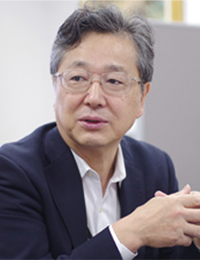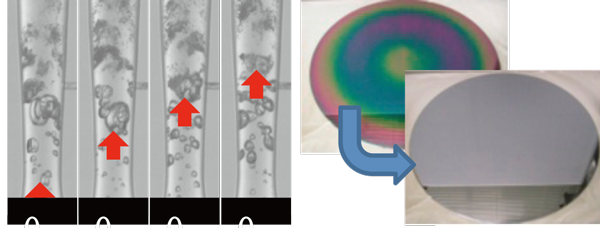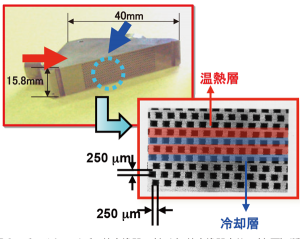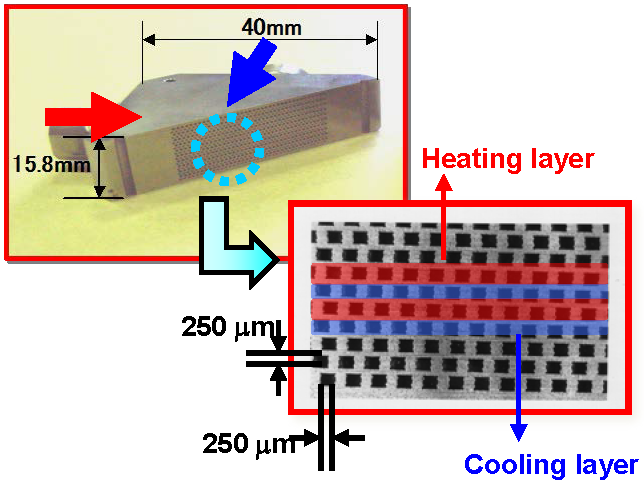キーワード: 環境調和型エネルギーシステム、エネルギー変換、エネルギーネットワーク、環境評価、災害リスク

インタビュイー:阿部 豊教授(前代表)
http://www.kz.tsukuba.ac.jp/eeru/
環境への影響を考慮した新技術を開発します。企業との連携プレーでエネルギー関連技術だけでなく、洗浄技術なども、理論(熱力学、流体力学)、実験、計測、シミュレーション(可視化)の手法を総動員で研究します。
本ユニットが対象とするのは、(1) 熱流体場の能動制御、(2) 小型分散型エネルギー源と大規模集中型エネルギー源を結合する新たなエネルギーネットワーク構築、(3) エネルギー機器の健全性評価技術および要素材料の特性評価、(4) 日本社会の持続可能な発展を支えるエネルギーシステムの総合的な分析評価、(5)環境評価,環境制御,環境予測など、大変広い範囲を対象としています。
環境に優しいマイクロバブル洗浄法

図1:マイクロバブル洗浄法
( 左)ベンチュリ管を用いた微細気泡生成、 ( 右)高濃度オゾン水による洗浄結果
IT技術の基礎となる半導体基盤の台となるウエハーのような超精密機器用の材料の洗浄には従来、「熱濃硫酸」といういかにも危険な薬品が使われます。洗浄に使った廃液は環境を汚染しないように十分な処理が必要です。それに対して私たちは、ベンチュリー管を用いたマイクロバブル洗浄法、という環境負荷が全く無い強力な洗浄法を開発しております。ほとんどの洗浄が化学薬品による化学の力での洗浄なのに対し、我々の方法は直径100ミクロン以下の小さい泡(マイクロバブル)の力を用いて、様々な機械材料の洗浄を行います。普通の空気の泡でも洗浄力がありますが、泡の中をオゾンにするとさらに高い洗浄力を発揮します。オゾンを使う場合でも、オゾンはすぐに自然に分解して酸素になるので全く環境負荷がありません。私たちは、ベンチュリー管という一度細くなりまた広がる管に気体を通してマイクロバブルを作っていますが、その様子を可視化し音速を超える衝撃波ができることがわかり、それによっても洗浄力が向上することが分かりました。
一方で、オゾンの持つ特別の洗浄力を最大限に活用するには分解が速すぎてもいけません。工学ではそんな場面で「最適化手法」が登場します。たまたま上手くいったというのも、出発としては大事ですが、何がどんな仕組みで働いて、欲しい性能を出すのか、学理を深く理解するのが企業との共同研究において、大学が果たすべき重要な役割です。それによって「最適化」が可能になります。
エアコンの室外機が手のひらサイズに

図2:手のひらサイズの熱交換器:(左上)熱交換器本体、(右下)断面図
エアコンの冷房では室内の熱を室外に逃がすための冷媒液が、太いパイプを通って室外機にゆき、室外機の扇風機で熱を室外に発散します(熱交換)。面白いことは私たちの技術では、あの大きな室外機以上の性能が手のひらサイズで実現できます。秘密は冷媒の通り道を髪の毛ほどのサイズに作った仕組みです。この仕掛けで熱交換の効率が100倍になり、その分室外機を非常に小さくできました。ここでも大学の研究として大事な仕事は仕組みを明らかにすることです。髪の毛の太さのなかの流体の動きを可視化し、流体が途中で気化する様子を捉えることができました。
この例のようにエネルギーに関係した研究を私たちは他にも多く行っています。バブル時代のエネルギー保全が軽んじられる時も、震災直後の省エネルギーが重視されるときも、昨今の異常な原油安のときでも、ブレる事なく物理と化学の基礎を明らかとし、明らかとした原理を基に汎用性のあるものを提供するのが大学研究の役目と考えています。
社会への貢献・実績
- 熱交換器をマイクロチャンネル積層型熱交換器として製品化(図2)
( http://www.welcon.co.jp/jp/)
取材:平成27年8月26日
Development of environmentally-friendly new technologies based on principles
Unit members : Abe, Yutaka Hatano, Yuko 奥野 光 Okajima, Keiichi Hanada Nobuko Kyotoh, Harumichi Kaneko, Akiko Ishida, Masayoshi Shirakawa, Naoki Kanagawa, Tetsuya Takewaka, Satoshi 中山 知紀
Unit name: Energy and Environment
Keywords: environmental conscious energy systems, energy conversion, energy networks, environmental assessment, disaster risk

interviewee; Abe, Yutaka
The unit aims to develop new technologies while taking into consideration their influences on the environment. Members of the unit conduct research on both energy-related and cleaning technologies in collaboration with companies, using all types of methods, including theories (thermodynamics, liquid dynamics), experiments, measurements, and simulations (visualization).
The unit covers a wide variety of subjects: (1) active control of thermal fluid fields, (2) development of new energy networks combining small-scale distributed and large-scale centralized energy sources, (3) technologies for the assessment of the soundness of energy equipment and the characteristics of element materials, (4) comprehensive analytical evaluation of energy systems to support the sustainable development of Japanese society, and (5) environmental assessment, control, and prediction.
Environmentally-friendly micro bubble cleaning method

Figure 1: Micro bubble cleaning method
(Left) Creation of microscopic bubbles using venturi tubes
(Right) Results of cleaning by high-concentration ozone water
To clean wafer, a material used for ultraprecision equipment as the platform of semiconductor substrates – a basic of IT technology, the hazardous “hot concentrated sulfuric acid” has conventionally been used. It is necessary to adequately treat liquid waste to prevent environmental pollution. To address this problem, we have developed a micro bubble cleaning method using venturi tubes, an effective cleaning method that is completely environmentally friendly. Whereas most conventional cleaning methods utilize the effects of chemicals, our method utilizes micro bubbles with a diameter of 100 μm or smaller to clean a variety of materials used for machines. The cleaning performance of the bubbles of ozone is higher than that of air bubbles. Ozone is decomposed to oxygen on its own in a short period of time, and is completely environmentally friendly. We produce micro bubbles by sending air through the venturi tube, a tube with a short and narrow center section and widened and tapered ends. We visualized this process, and learned that shock waves faster than the speed of sound and with a higher cleaning ability are created during the process.
On the other hand, the unique cleaning ability of ozone cannot be most effectively utilized when the decomposition rate is exceedingly high. In engineering, “optimization approaches” are used in these situations. An accidental discovery can be an important starting point for research. However, in collaborative research with companies, universities should fulfill the important role of improving the comprehension of theories, e.g., what achieves desired performance as well as its mechanism. Through these efforts, universities accomplish “optimization”.
Air conditioner outdoor unit that fits into the palm

Figure 2: Heat exchanger that fits into the palm
(Upper-left) Body of a heat exchanger
(Lower-right) Cross-sectional diagram
When an air conditioner cools a room, refrigerant liquid is sent to the outdoor unit through a thick pipe to release the heat in the room outside, and the fan of the outdoor unit diffuses the heat (heat exchange). Interestingly, the performance of our originally-developed device that fits in the palm is higher than that of a large outdoor unit. The key to its success was a pathway for refrigerant liquid as thin as hair. The mechanism adopted for the device has increased the efficiency of heat exchange 100 times, and the size of the outdoor unit has become significantly small. As explained in the preceding paragraph, research conducted in universities should clarify these mechanisms. We were able to visualize the movement of fluid and observe its vaporization.
We also conducted many energy-related studies other than the above-mentioned research. We believe that researchers of universities should consistently examine the basics of physics and chemistry and develop the suggested principles into general purposes, regardless of changes in social trends such as less emphasis on energy conservation during the period of the bubble economy, emphasis on it during the post-earthquake period, and significant decreases in crude oil prices in recent years.
Social contributions and achievements
– Commercialization of a micro-channel laminated heat exchanger (Figure 2)
(http://www.welcon.co.jp)
Interviewed on August 26, 2015
